
Dimdima
Online Children's Magazine from India

Dimdima
Online Children's Magazine from India
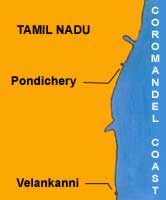
Leaving the Gulf of Mannar behind, we arrive at the Coromandel coast, immortalised in the poem 'The Coromandel
Fishers' by Sarojini Naidu, the 'Nightingale' of India. The cromandel coast is wellknown for its religious shrines. One of the most visited pilgrim centres on the Coromandel coast is the Church of Our Lady of Health at Velankanni.
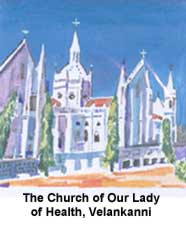
Devotees throng the church and those cured of their ailments donate gold and silver replicas of the particular part of the body that was healed. The church has a museum where these replicas are displayed. A passage, whose walls have
pictures depicting stories from the Bible, leads to the original church situated near the seashore.
Nagapattinam, a minor port, lies a few kilometres to the north of Velankanni. It was a famous port in ancient times
and served as a Pallava naval base in the 5th century A.D. Hardly 24 kilometres inland is Tiruvarur, the birthplace of Tyagaraja who, along with Muthuswami Dikshitar and Shyama Shastri, comprise the Trinity of Carnatic Music.
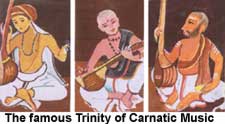
Four kilometres to the north of pattinam is Nagore, well-known for the dargah of Hazrat Meeras Sultan Syed Shahabdul Hameed or Hazrat Mian. People of all faiths visit the 500-year-old dargah with its golden dome, flanked by five minarets. The tank inside the dargah compound is believed to have curative properties.
Nagore is also known for its palmleaf handicrafts which include shopping bags, dinner cases and ornamental folding
fans. Moving further north we reach Karaikal, an ancient pilgrim centre. It is one of the four districts of the Union Territory of Pondicherry.
The saint-singer Karaikal Ammiyar, whose songs are regarded as the oldest among the available Saivite devotional songs,
lived here in the 6th century A.D. Three of her famous works are Arputat- Tiruvantati, Irattai-Manimalai and Mutta- Tiruppatikankal.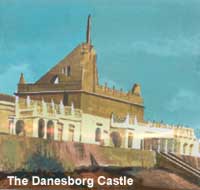
Karaikal Ammiyar's husband left her when he came to know that she possessed mystical powers. Hurt by his behaviour
she became a wandering minstrel and went from temple to temple singing devotional songs. She is remembered today for her beautiful songs. There is a temple dedicated to her at Karaikal.
Our next port of call is Tarangambadi or Tranquebar, once a Danish settlement. It was Denmark's only Asian holding from
1620 till 1840.The main city remains much the same way as when the Danes had built it. Danesborg castle and fort, the
200-year-old gate through which the citizens have to pass on their way out and into the town, Rehling's Gard, the house in which the last Danish Governor, Johnnaes Rehling, lived between 1823 and 1841 and a couple of churches, stand as
testimony to the city's Danish past.
North of Tarangambadi, at the mouth of the Kaveri, is Poompuhar. It was once a prosperous port city of the Chola empire and carried on an extensive trade with countries like Myanmar, Sri Lanka, Malaysia, Indo-China and China proper.
According to a legend, the festival of Indrapuja was held here every year in summer. One year, for some reason, the
festival could not be held. This made Manimekalai, the sea-goddess, so angry that she caused a fierce typhoon and
the sea swallowed up the city and the port.
In 1962, excavations carried out at Kilaiyur in the vicinity of Poompuhar, proved that the original city had indeed been submerged by the sea. Poompuhar was also a centre of Buddhism. In fact the Tamil classic, Manimekalai, was composed for the propagation of Buddhism.
From Poompuhar, our journey takes us to Chidambaram, known as the City of the Cosmic Dancer. The celebrated Natraja
temple stands at the city'S centre. It is dedicated to Lord Siva, the Cosmic Dancer.
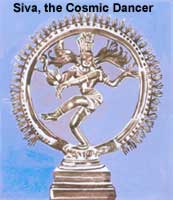
Legend has it that the famous dance competition between Siva and Parvati, to see who could perform better, was held here.
Both were perfectly matched. Anything Siva did, Parvati could do equally well and vice-versa. The heavenly creatures
who had assembled there found it impossible to decide who was the better dancer. Just then, Siva performed a yogic feat. He stood on one leg and lifted the other high above his shoulder and looked at Parvati challengingly. Inhibited by modesty from imitating such a posture, Parvati admitted defeat.
The temple's rectangular sanctum has the idol of Siva in this posture.The idol is made from an alloy of five metals and the sanctum is covered with copper tiles and gold. Our next halt is at Pondicherry, the capital of the Union
Territory of Pondicherry- a city with a rich, colourful past. The Romans, the Portuguese, the French, the Dutch and
the British had all set up trading-posts and settlements here from the 1st century A.D. to the present century. From 1814 to 1954 Pondicherry remained in French hands.
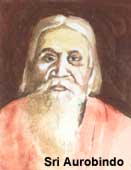
During the country's struggle for freedom, Pondicherry was a haven for freedom fighters. It was here that poet Subramanya Bharati composed patriotic songs and carried on national propaganda. He ushered in a new era in Tamil literature with songs like L S Kannan Pattu, Kuyil pattu and Panchali
Saptham. His fiery songs have become immortal and are sung with pride by the people of Tamil Nadu. His house at 20,
Eswaran Dhannarajakoil Street has been declared a national monument.
Another freedom fighter who took refuge in this French enclave was Sri Aurobindo Ghose. He came to Pondicherry in 1920 and began to lead a spiritual life, writing several philosophical books of which Life Divine, Savitri and The
Interpretations of the Gita, Upanishads and the Vedas are considered to be his best works. To put his ideals of peaceful community living into practice, Aurobindo started an ashram along with the Holy Mother( Mirra Alfassa, a French disciple who helped, supported and guided him from 1920 until his death in 1950 and continued as his spiritual successor until her death in 1973). Auroville or the City of Dawn, 8 km away from Pondicherry, was set up in 1968 as a tribute to Aurobindo, who
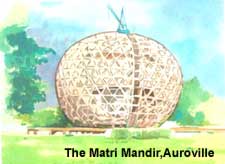 believed 'there should be somewhere on Earth a place that no nation can claim as sole property, a place where all human beings of goodwill, sincere in their spiration, could live freely as citizens of the world, staying on single authority, that of the Supreme Truth...'
believed 'there should be somewhere on Earth a place that no nation can claim as sole property, a place where all human beings of goodwill, sincere in their spiration, could live freely as citizens of the world, staying on single authority, that of the Supreme Truth...'
Last updated on :6/15/2005
Dimdima is the Sanskrit word for ‘drumbeat’. In olden days, victory in battle was heralded by the beat of drums or any important news to be conveyed to the people used to be accompanied with drumbeats.
Bharatiya Vidya Bhavan
K. M Munshi Marg,
Chowpatty, Mumbai - 400 007
email : editor@dimdima.com
Bharatiya Vidya Bhavan
505, Sane Guruji Marg,
Tardeo, Mumbai - 400 034
email : promo@dimdima.com
Dimdima.com, the Children's Website of Bharatiya Vidya Bhavan launched in 2000 and came out with a Printed version of Dimdima Magazine in 2004. At present the Printed Version have more than 35,000 subscribers from India and Abroad.